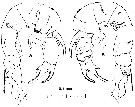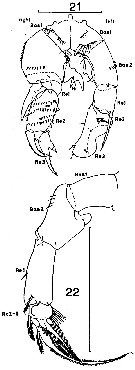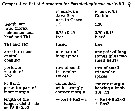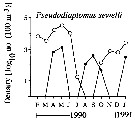|
|
 |
Fiche d'espèce de Copépode |
|
|
Calanoida ( Ordre ) |
|
|
|
Diaptomoidea ( Superfamille ) |
|
|
|
Pseudodiaptomidae ( Famille ) |
|
|
|
Pseudodiaptomus ( Genre ) |
|
|
| |
Pseudodiaptomus sewelli Walter, 1984 (F,M) | |
| | | | | | | Syn.: | Pseudodiaptomus aurivilli : Sewell, 1932 (p.240); Wellershaus, 1969 (p.254, figs.F,M); Pillai, 1980 (p.248) | | | | Ref.: | | | Walter, 1984 (p.383, figs.M; Rem.); 1986 (p.133); 1986 a (p.503); 1987 (p.367) |  issued from : T.C. Walter in Proc. Biol . Soc. Wash., 1984, 97 (2). [p.384, Fig.6]. Male (from Cochin Backwater, India): A, P5 (posterior view); B, idem (anterior view).
|
 Issued from : S. Wellershaus in Veröff. Inst. Meeresforsch. Bremerh., 1969, 11 (2). [p.255, Fig.21-22]. As Pseudodiaptomus aurivilli. Female (from Cochin Backwater, India): 22, P5. Nota: Exopodal segment 1 of P5 bears only one hair on the outer margin. Ratio cephalothorax: urosome = 1,7; Length of the caudal rami = 7 x breadth. Male: 21, P5. Nota: Proportions of the urosomal segments 11 : 20 : 18.5 : 18.5 : 9, caudal rami 23 %. The spine of the outer corner of the 5th thoracic segment is shorter than in the female. As in the female there is a pair of black dots in the anal segment. Spikes are on the whole posterior margin of abdominal 2, 3 and 4, and additional spinules on the ventral aspect of abdominal 2, 3 and 4
Scale : single line = 0.1 mm ; double line = 0.05 mm.
|
 Issued from : S. Wellershaus in Veröff. Inst. Meeresforsch. Bremerh., 1969, 11 (2). [p.257, Table 2]. Comparative list of characters for Pseudodiaptomus aurivilli female (from Cochin Backwater, India) (= Pseudodiaptomus sewelli Walter, 1964) and Pseudodiaptomus aurivilli Cleve, 1901 (from Java Sea)
|
 Issued from : S. Wellershaus in Veröff. Inst. Meeresforsch. Bremerh., 1969, 11 (2). [p.255]. As Pseudodiaptomus aurivilli. Female (from Cochin Backwater, India): Proportion of the abdominal segments and length of the caudal setae (in % of abdomen length). Nota: Ratio thorax : abdomen = 1.7.
| | | | | Ref. compl.: | | | Madhupratap & Haridas, 1986 (p.105, tab.2); Tiwari & Nair, 1993 (p.67); Ramaiah & al., 1996 (p.2); Ramaiah & Nair, 1997 (tab.1); Achuthankutty & al., 1998 (p.1, Table 2, fig.5, seasonal abundance vs monsoon); Maiphae & Sa-ardrit, 2011 (p.641, Table 2, 3, Rem.) | | | | NZ: | 1 | | |
|
Carte de distribution de Pseudodiaptomus sewelli par zones géographiques
|
| | | | | |  issued from : C.T. Achuthankutty, N. Ramaiah & G. Padmavati in Pelagic biogeography ICoPB II. Proc. 2nd Intern. Conf. Final report of SCOR/IOC working group 93, 9-14 July 1995. Workshop Report No. 142, Unesco, 1998. [p.8, Fig.6]. issued from : C.T. Achuthankutty, N. Ramaiah & G. Padmavati in Pelagic biogeography ICoPB II. Proc. 2nd Intern. Conf. Final report of SCOR/IOC working group 93, 9-14 July 1995. Workshop Report No. 142, Unesco, 1998. [p.8, Fig.6].
Salinity ranges for P. sewelli in coastal and estuarine waters of Goa (India).
Shaded area indicates the range of higher abundance. |
 issued from : C.T. Achuthankutty, N. Ramaiah & G. Padmavati in Pelagic biogeography ICoPB II. Proc. 2nd Intern. Conf. Final report of SCOR/IOC working group 93, 9-14 July 1995. Workshop Report No. 142, Unesco, 1998. [p.6, Fig.5]. issued from : C.T. Achuthankutty, N. Ramaiah & G. Padmavati in Pelagic biogeography ICoPB II. Proc. 2nd Intern. Conf. Final report of SCOR/IOC working group 93, 9-14 July 1995. Workshop Report No. 142, Unesco, 1998. [p.6, Fig.5].
Monthly occurrence of Pseudodiaptomus sewelli in coastal (black circle) in front of Goa and and the Mandovi estuary (clear circle). |
 issued from : C.T. Achuthankutty, N. Ramaiah & G. Padmavati in Pelagic biogeography ICoPB II. Proc. 2nd Intern. Conf. Final report of SCOR/IOC working group 93, 9-14 July 1995. Workshop Report No. 142, Unesco, 1998. [p.3, Fig.2]. issued from : C.T. Achuthankutty, N. Ramaiah & G. Padmavati in Pelagic biogeography ICoPB II. Proc. 2nd Intern. Conf. Final report of SCOR/IOC working group 93, 9-14 July 1995. Workshop Report No. 142, Unesco, 1998. [p.3, Fig.2].
Hydrography of the coastal station in front of Goa and Mandovi estuarine station (W India).
Nota: The seasons are arbitrarily classified into the southwest monsoon (June-September), postmonsoon (October-January) and premonsoon (February-May). |
| | | | Loc: | | | India (Bombay, Goa, Bengal, Cochin, Burhabalanga estuary), Andaman Sea | | | | N: | 8 | | | | Lg.: | | | (172) F: 1,26; M: 0,94; (802) F: 1,26; M: 0,94; {F: 1,26; M: 0,94} | | | | Rem.: | estuaire-néritique.
Incomplete data.
Voir aussi les remarques en anglais | | | Dernière mise à jour : 18/12/2017 | |
|
|
 Toute utilisation de ce site pour une publication sera mentionnée avec la référence suivante : Toute utilisation de ce site pour une publication sera mentionnée avec la référence suivante :
Razouls C., Desreumaux N., Kouwenberg J. et de Bovée F., 2005-2025. - Biodiversité des Copépodes planctoniques marins (morphologie, répartition géographique et données biologiques). Sorbonne Université, CNRS. Disponible sur http://copepodes.obs-banyuls.fr [Accédé le 05 janvier 2026] © copyright 2005-2025 Sorbonne Université, CNRS
|
|
 |
 |








